“Let Me Introduce You: Cultivating History in Brookside’s Sideyard”
By Kathleen Royka

Are you aware that a charming Colonial Herb Garden is tucked in Brookside Museum’s sideyard? Established in 1980, the Beverly and Harold Ricks Memorial Garden is dedicated to that couple, whose vision and hard work gave birth to Brookside’s precious plot. In Bev’s words, “Working with Field Horne, the museum director, we decided to plant a Colonial Garden to complement the museum’s programs.” In the more than forty years since, the Thymly Herb Group has underwritten and cared for the garden. The plants speak of the past—of our immigrant ancestors who braved the voyage across the Atlantic, settled among the coastal Americans of this continent, and bore generations of settlers who, in turn, ventured farther West, coming to reside in the greater Saratoga area, where healing springs flow.
The garden is divided into four sections: culinary, medicinal, dye, and fragrance. Each features herbs that were commonly used during the colonial and postcolonial eras. Sections are separated by a cruciform walk, a formal design not typical of the times. The culinary bed is more common, as vegetables and herbs are planted together as they were in kitchen gardens during those periods.

Every day, there is something new in the garden, from tulips in April to the last calendula blossoming in October. Join me for this mini-tour of the garden, and come visit in person when the grounds reopen in the spring.

Florentine iris
May in the fragrance bed . . .
These lovely and fragrant blossoms are not the reason Florentine iris is growing in the fragrance bed. Florentine iris has another name: orris root. The word root is the key to its use. Every two or three years, the rhizomes are lifted and divided after the flowers fade. Some are replanted and others are prepared for drying. Three years later, when the dried rhizomes are ground, the scent of violets floods the air. When added to potpourri, the properties of the powdered rhizomes help enhance and extend the life of the fragrance.

La Perle
June in the fragrance bed . . .
This plant holds a special place in my heart. I first saw the blossoms reflected in a small pool in my grandmother’s garden. I imagine that she acquired her peony from her mother’s garden as my dad did from hers, and as I did from my dad’s. It was hybridized in France and given the name La Perle. The blossoms are very fragrant and pink on opening. The pink fades and before the petals fall the blossoms are pure white.
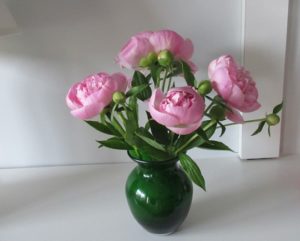
I was skeptical when Marilyn, a THG member, knowledgeable gardener, and friend, suggested we harvest some buds and delay blossoming so we could showcase the blooms at the Secret Garden Tour last July. She gave me detailed instructions before she left for the summer. I followed her directions carefully: I cut the buds when they hinted at color and felt like a marshmallow; I then wrapped the stems in damp paper towels; and, because I knew my husband would toss out the flowers if any ants began walking around in the fridge, I put the bouquet into a large zip lock bag and hid it at the back of a shelf! A day before the tour, Marilyn texted, “Take the buds out of the fridge and put the stems in warm water.” Amazing, I could almost see the petals unfurl. The bouquet was the hit of the tour!
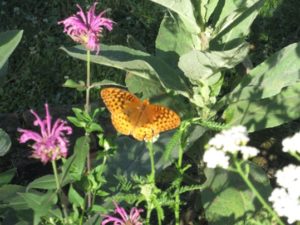
Bee balm
July in the medicinal bed . . .
Butterflies are jewels as they flit from flower to flower. I was thrilled when this great spangled fritillary appeared, and I stood spellbound until it fluttered away. Bee balm’s flowers attract both butterflies and hummingbirds, and this makes the flowers a favorite of mine.
Indigenous Americans made tea from the flowers and leaves of bee balm, and drank the tea for both medicinal and pleasure purposes. When Indigenous Americans living in Otsego County introduced the plant to European colonists, neither had any idea of the role it would play in history. After “patriots,” role-playing as “Indians,” tossed tons of tea into Boston Harbor to protest Parliament’s imperial policies (an event that later came to called the “Boston Tea Party”), local Otsego/Oswego tea became the tea in the Northeast colonies. That same region was later made famous by James Fenimore Cooper in his Leatherstocking Tales. (Cooper visited the Brookside mansion when it was a hotel called Aldridge House.)
Why, you may ask, we did not plant the bright red variety? The plants in the garden are not a hybrid but the same bee balm that grew wild in colonial and postcolonial times.
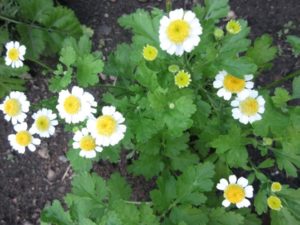
Feverfew
August in the dyers’ bed . . .
Another query you might have is, Why would feverfew be planted in, of all places, the dyers’ bed? You are right when you say its name clearly indicates that it’s a medicinal herb used to help reduce fever. But here it is in the dyers’ bed, and with good reason. The flowers and stems make a yellow dye. Feverfew is a plant with several talents, but not all are equally beneficial. It contains an ingredient that repels insects, and in all my years of gardening, I have never seen any insect land on its blossoms or foliage. The dried blossoms can be ground and mixed with water to make an insecticide which should be applied directly on infested plants. Although a natural insecticide, it’s not used in the garden.
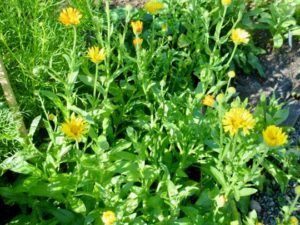
Calendula
September in the culinary bed . . .
Even on a gloomy day, calendula blossoms bring sunshine to the garden. And under September’s ultramarine skies, the blossoms glow like pirates’ doubloons. The edible blossoms are traditionally used to tint butter and custards. Dried and ground flowers can be used as a saffron substitute.
This plant has the credentials to be in every bed in the garden. It is used medicinally, for dye, and can be dried to add color to winter bouquets. In 16th-century England, a potion made from calendula was believed to have magic so powerful that the fairy world would be revealed to those who dared drink the potion. Could this have been Washington Irving’s inspiration for “Rip Van Winkle”?
The autumnal equinox has passed. The herb garden soon will be put to bed for the winter. Our thoughts turn toward spring and next year in the garden. Join us then to see this hidden treasure where history is cultivated in Brookside’s sideyard.
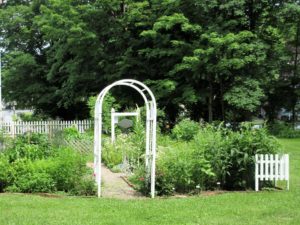
Photos and text by Kathleen Rebmann Royka
Research: Kowalchik, Claire & Hilton, William H, Editors. Rodale’s Illustrated Encyclopedia of Herbs. Emmaus, PA: Rodale Press, 1998.
















